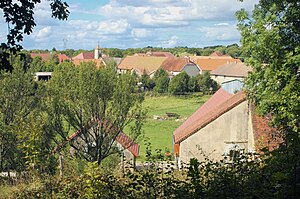Nogna
| Nogna | ||
|---|---|---|
|
|
||
| region | Bourgogne-Franche-Comté | |
| Department | law | |
| Arrondissement | Lons-le-Saunier | |
| Canton | Poligny | |
| Community association | Region d'Orgelet | |
| Coordinates | 46 ° 36 ' N , 5 ° 39' E | |
| height | 497-623 m | |
| surface | 6.11 km 2 | |
| Residents | 295 (January 1, 2017) | |
| Population density | 48 inhabitants / km 2 | |
| Post Code | 39570 | |
| INSEE code | 39390 | |
 View of Nogna |
||
Nogna is a commune in the French department of Jura in the region Bourgogne Franche-Comté .
geography
Nogna is located at 555 m , about eleven kilometers southeast of the city of Lons-le-Saunier (as the crow flies). The farming village extends in the Jura , in the extreme south of the Plateau Lédonia (first Jura plateau), west of the heights of the Côte de l'Today with the Château de Beauregard.
The area of the 6.11 km² large municipality covers a section of the French Jura. The main part of the area is taken up by the plain of the Plateau Lédonia, which lies at an average of 540 m and consists partly of arable land and meadow, partly of forest. The plateau has no above-ground watercourses because the rainwater seeps into the karstified subsoil. To the east, the municipal area extends to the heights of the Côte de l'Heute , on which the highest point of Nogna is reached at 623 m . The ridge of the Côte de l'Today is interrupted here by a ridge-like valley that connects to the valley of the Combe d'Ain .
Neighboring communities of Nogna are Publy in the north, Mesnois in the east, Marnézia in the south and Poids-de-Fiole in the west.
history
Various finds indicate that the municipality of Nogna was already settled during the Gallo-Roman period. The chapel of Nogna was first mentioned in a document in the 12th century. In the Middle Ages, the village belonged to the Barony of Binans. Together with Franche-Comté , it came to France with the Peace of Nijmegen in 1678. In 1820 Poids-de-Fiole was merged with Nogna. The separation took place as early as 1839, and since then both localities have formed independent communities.
Attractions
The village church of Saint-Barthélemy was built in the 18th century. Remains of the former manor Château-Faratte have been preserved.
population
| Population development | |
|---|---|
| year | Residents |
| 1962 | 183 |
| 1968 | 185 |
| 1975 | 169 |
| 1982 | 187 |
| 1990 | 192 |
| 1999 | 203 |
| 2004 | 227 |
With 295 inhabitants (as of January 1, 2017), Nogna is one of the small communities in the Jura department. After the population had decreased significantly in the first half of the 20th century (337 people were still counted in 1886), slight population growth has been recorded again since the mid-1970s.
Economy and Infrastructure
Until well into the 20th century, Nogna was a village dominated by agriculture and forestry. In addition, there are now some local small businesses. In the meantime, the village has also turned into a residential community. Many workers are commuters who work in the larger towns in the area.
The village is very well developed in terms of traffic. It is on the main road N78, which leads from Lons-le-Saunier to Saint-Laurent-en-Grandvaux . There are other road connections with Poids-de-Fiole, Marnézia and Publy.
